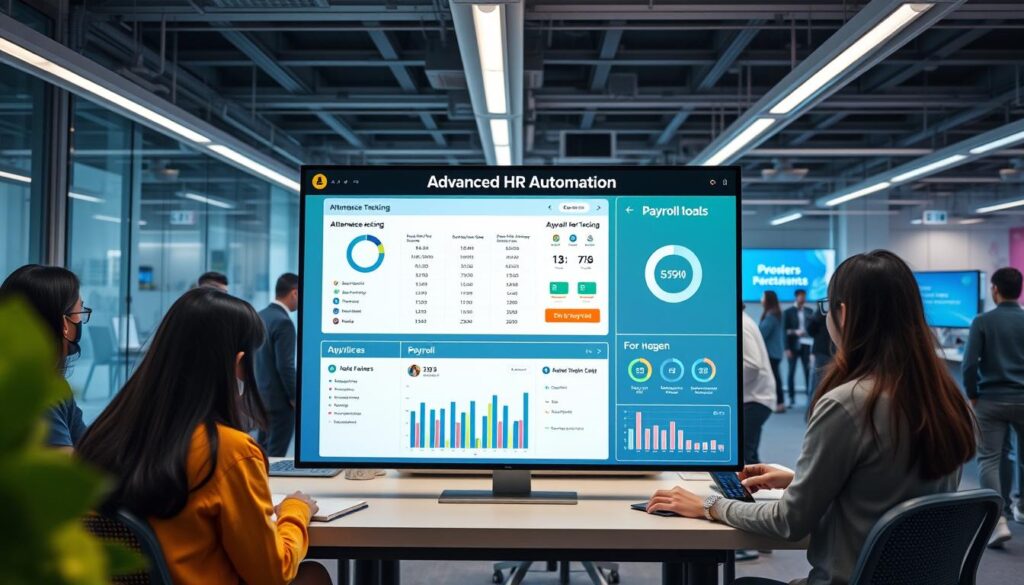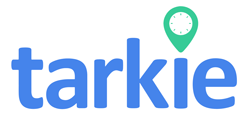Ever thought about how much money your business loses because of old attendance tracking methods? Up to 7% of gross payroll can be lost due to time-tracking problems like time theft and manual errors. In today’s fast-paced world, linking attendance tracking with payroll is essential, not just a nice-to-have, for small and medium businesses in the Philippines.
Switching from manual to automated payroll boosts efficiency and cuts down on mistakes and paperwork. With the help of advanced HR automation, businesses can share data instantly. This means employees get paid on time and correctly. A happy and productive team leads to better business growth.
Key Takeaways
- Linking attendance tracking with payroll greatly reduces manual data entry errors.
- Companies using automated time-tracking see a big drop in payroll mistakes.
- Real-time monitoring tools help keep accurate time records and speed up payroll.
- Setting up attendance policies makes payroll more accurate and cuts down on errors.
- Automation can save a lot on labor costs and administrative expenses.
The Importance of Attendance Tracking in Modern Business
Accurate attendance tracking is key to a business’s success today. It boosts operational efficiency and solves problems of old methods. It also builds trust among employees by ensuring correct and timely pay.
Enhancing Operational Efficiency
Modern attendance tracking solutions cut down on errors and make admin tasks smoother. Old ways of tracking often lead to mistakes. Using new technology saves money by reducing time spent on paperwork.
- Real-time data helps managers make quick decisions.
- Mobile access makes it easy for remote workers to track their hours.
- Custom reports help understand attendance patterns.
Impact on Employee Trust and Satisfaction
Good attendance tracking systems give employees control over their records. This boosts trust and satisfaction. It also helps avoid fines for not following labor laws, making employees feel more secure.
| Benefits of Attendance Tracking | Traditional Methods | Automated Systems |
|---|---|---|
| Errors and Rectification | 80% require corrections | 44% reduction in errors |
| Cost of Absenteeism | $2,660 per shift worker | Less demand for overtime |
| Impact of Time Theft | Estimated losses of $11 billion annually | Reduction in buddy punching with integrated systems |
Challenges with Traditional Attendance and Payroll Processes
Traditional attendance and payroll systems often face many problems. They can make managing the workforce less accurate and less efficient. Issues like manual entry errors cause delays in payroll, affecting everyone involved.
These errors not only mess up payment schedules but also add stress to HR teams. They have to deal with fixing mistakes and sorting out differences. Automated systems can help solve these big challenges.
Manual Entry Errors and Delays
Payroll mistakes can happen in 1-8% of cases with old systems. These errors lead to problems that upset employees and need a lot of time to fix. Companies that track attendance manually lose up to 30 hours of productivity each month.
This makes it hard to get payroll done on time. It can also hurt employee happiness.
Compliance Risks and Legal Issues
Old systems also bring big risks of not following the law. Companies must follow many rules about pay, work hours, and employee rights. If they don’t, they could face big fines.
About 60% of companies see better compliance after using automated attendance systems. This shows that using these systems can really help avoid legal problems.

What Is Payroll Integration?
Payroll integration connects attendance tracking systems with payroll processes. It makes work flow better, making things more accurate and efficient. It helps automate tasks, cuts down on errors, and speeds up payroll processing.
Understanding the Basics
When payroll systems and attendance tracking are integrated, it automates many calculations. This ensures that what employees earn matches their work hours. Studies show that using payroll integration can cut down manual data entry by up to 30%.
This leads to faster and more efficient payroll processing. It helps avoid the problems that come with old systems.
Key Features of Payroll Integration Systems
Effective payroll integration systems have key features. These include:
- Real-time data transfer: It makes sure payroll calculations are always up to date and accurate.
- Automated calculations: It greatly reduces errors, cutting down payroll mistakes by 20%.
- Compliance checks: It keeps track of labor laws and updates tax tables as needed.
- Enhanced auditing: It leads to a 60% better internal audit performance, thanks to accurate data.
- Scalability: These systems grow with your business, supporting new payroll needs.
Payroll software does more than just make things efficient; it improves the employee experience. Companies with integrated payroll and HR systems see a 15% better interaction with employees. It lets employees easily access their payroll info through one easy-to-use platform.
How Automated Payroll Functions Work
Automated payroll functions are key to making businesses more efficient. They make payroll calculations easy and fast, turning a hard task into a smooth one. With real-time data, businesses can pay employees on time and accurately.
Streamlining Payroll Calculations
Automated payroll systems handle complex calculations well. They cut down on errors by avoiding manual input. This can save a business up to 40% on payroll costs.
Manual payroll takes 5 to 10 hours a month. But automation can do it in 1 to 3 hours. This frees up HR to focus on more important tasks.
Integrating Time Data for Real-Time Processing
Automated payroll is great at using time data right away. It makes sure every work hour is recorded without delay. This boosts payroll accuracy to over 98%.
It also makes following rules easier, reducing the chance of costly mistakes. These mistakes can lead to fines from government agencies.
Automated payroll also cuts down on manual work, making things more efficient. It makes employees happier because they get paid on time. With today’s tech, businesses can quickly adjust to changes in costs and productivity.
| Feature | Manual Payroll Process | Automated Payroll Process |
|---|---|---|
| Time Required for Processing | 5 to 10 hours/month | 1 to 3 hours/month |
| Error Reduction | Up to 90% | Up to 98% |
| Employee Satisfaction Increase | – | 20% |
| Cost Savings on Processing | – | 40% |
| Compliance Risk Management | High | Low |
Benefits of Integrating Attendance Tracking with Payroll
Integrating attendance tracking with payroll brings many benefits to businesses. One big advantage is the improved accuracy from syncing data. This reduces errors, mainly from manual entry. It makes operations smoother and boosts workforce efficiency.
Improved Accuracy and Reduced Errors
Companies that use integrated systems see a big drop in payroll time. For example, ACME Corp cut its time by 40% with an automated system. Also, payroll errors can fall by 40% with automation.
This means employees get their paychecks right on time. It builds trust and satisfaction in the workplace.
Enhanced Workforce Management
Integration gives HR teams and managers key insights into attendance and performance. This helps make better decisions. It creates a place where companies can tackle issues well.
Studies show systems like this can increase productivity by 20%. They also cut time fraud by up to 25%. So, businesses run better and employees are happier, with paychecks processed faster and more accurately.
Payroll Integration, Automated Payroll, Workforce Efficiency
In the Philippines, many businesses are moving to payroll integration and automated systems. This change makes processes smoother and tackles payroll challenges. Many industries are seeing big benefits from these new solutions.
Real-World Applications and Examples
Many sectors are using payroll integration to improve operations. For example, companies with automated payroll have cut their processing time by 35%. This is thanks to linking HR systems with payroll.
- Companies have seen a 25% drop in payroll errors, making things more accurate and compliant.
- Automated payroll cuts down on non-compliance risks, reducing penalties and fines by ensuring on-time filings.
- Real-time analytics help businesses track labor costs and find ways to save money.
Also, using employee self-service portals has greatly reduced administrative work. Employees can manage their own payroll data, leading to higher job satisfaction.
Case Study: Success in Philippine SMEs
Philippine SMEs have greatly benefited from integrated payroll solutions. A recent survey showed a 40% cut in payroll processing time for companies using these systems.
| Benefit | Percentage |
|---|---|
| Reduction in Payroll Processing Time | 35% |
| Decrease in Payroll Errors | 25% |
| Reduction in Administrative Workload | 25% |
| Boost in Employee Satisfaction | 30% |
Using payroll integration helps these companies meet reporting standards and boost efficiency. Automated systems let them track labor costs better, leading to better operations. So, moving to automated payroll is key for businesses to succeed today.

Choosing the Right Attendance Tracking System
Finding the right attendance tracking system is key for businesses wanting to improve operations and productivity. Important features can greatly affect how well the system works and if it meets your needs.
Essential Features to Look For
When looking at attendance tracking systems, focus on these key features:
- User-friendly interface: Makes it easy for employees to use.
- Real-time data access: Lets managers check attendance anytime and make changes.
- Robust reporting capabilities: Gives insights into attendance patterns, helping spot issues.
- Integration with payroll systems: Makes payroll more accurate and easier.
These features help improve how well your business runs. About 70% of small and medium-sized businesses see better productivity after using automated attendance tracking.
Scalability and Customization Options
As your business grows, it’s important to have a system that can grow with you. A good system can handle up to 200% more users without slowing down. This lets your business adapt to new needs without changing everything.
Customization is also key. It lets businesses make the system fit their unique policies and practices. Companies that customize their systems see up to a 20% drop in payroll mistakes. This makes the system work better with your current processes, boosting efficiency.
Integrating with Existing Payroll Software
Linking attendance tracking systems with current payroll software boosts efficiency. It’s key to look at compatibility considerations for smooth operation. This ensures the integration works well and doesn’t mess up payroll.
Compatibility Considerations
When merging payroll software, check your tech setup. Look at your payroll software’s version, what it can do, and what the attendance tracking needs. Here are important things to think about:
- See if APIs are available for easy data sharing.
- Make sure the systems work well together with your databases.
- Check if the data formats and processing standards match.
- Know the limits of your current payroll software with new solutions.
Best Practices for Implementation
Using best practices makes the integration smoother and safer. Here are some tips from experts:
- Test the systems together before using them live to find problems early.
- Train staff on the new setup to help them use it better.
- Keep an eye on how data moves between systems to spot any problems.
- Make sure IT, HR, and payroll teams talk well to work together better.

Maximizing the Value of Integrated Solutions
To get the most out of integrated solutions, focus on employee training. Teaching staff about new systems is key. It boosts productivity and makes the transition smoother.
Training Employees for Success
Training is vital for integrated solutions to work well. Companies that train well see better data and clearer costs. This helps make smart business choices and cuts down on mistakes.
Training should cover:
- How to use the integrated systems
- Best ways to enter and check data
- Updates on new system features
Monitoring and Continuous Improvement
Having a plan for checking and improving is crucial. It lets businesses grow their solutions. Regular checks help find and fix problems.
- It makes managing the workforce better
- It lowers penalties and incidents
- It can make operations 25% more efficient
Integrating attendance tracking with payroll cuts errors by up to 80%. It also saves about 12 hours per employee each month. Investing in training and improvement leads to lasting success in managing payroll and attendance.
Future Trends in Attendance Tracking and Payroll Integration
The world of attendance tracking and payroll is changing fast. New technologies and a move towards HR automation are leading the way. Companies that embrace these changes will likely stay ahead in managing their workforce.
Emerging Technologies in HR Automation
New technologies like artificial intelligence (AI) and machine learning (ML) are changing HR automation. These tools help predict and analyze data better. This means companies can save time and money on payroll.
Automating attendance tracking can cut payroll processing time by 15 to 20 hours each month. It also reduces errors by up to 90%, making payroll more accurate.
- Increased reliance on biometric technology, such as fingerprints and facial recognition for attendance tracking.
- Rise in cloud-based systems due to flexibility and cost-effectiveness.
- Mobile applications enabling remote clock-in/out functionalities.
- Growing emphasis on analytics and reporting to improve attendance management.
Forecasting the Future of Workforce Management
Businesses that focus on automation will see big improvements. They can cut operational costs by up to 30% and boost employee productivity. Automating HR can also make employees 25% happier by reducing their workload.
| Trend | Impact | Statistics |
|---|---|---|
| AI and ML Usage | Enhanced predictive capabilities | Companies reporting improved analytics |
| Biometric Technology Adoption | Increased security and accuracy | Reduction in unauthorized attendance |
| Cloud-Based Solutions | Cost-effectiveness and flexibility | Growth in remote access use |
| Mobile App Integration | Convenience for employees | Improved attendance tracking efficiency |
Companies that invest in HR automation are set to change workforce management. By adopting these trends, businesses can improve their performance. HR teams can then focus on more important tasks.

Conclusion
Integrating attendance tracking with payroll systems is now key for businesses wanting to work better. This move makes processes smoother and cuts down on mistakes from manual entry. Studies show errors can fall from 5% to less than 1%, proving these systems boost payroll accuracy.
Companies also see big gains in business efficiency when they use these systems. They can process payroll up to 50% faster and HR tasks 30% better. This lets teams work on important projects instead of just paperwork. For more on this, check out understanding payroll integration.
In the Philippines and worldwide, the benefits of linking attendance tracking with payroll are obvious. These systems help avoid fines and make employees happier with correct pay. They are crucial for growing and doing well in today’s fast-changing work world. Using these integrated solutions is not just good; it’s necessary for success.
